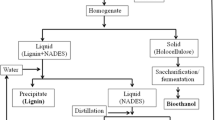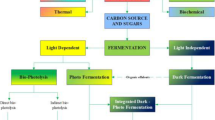Abstract
Continuous production of acetone, n-butanol, and ethanol (ABE) was carried out using immobilized cells of Clostridium acetobutylicum DSM 792 using glucose and sugar mixture as a substrate. Among various lignocellulosic materials screened as a support matrix, coconut fibers and wood pulp fibers were found to be promising in batch experiments. With a motive of promoting wood-based bio-refinery concept, wood pulp was used as a cell holding material. Glucose and sugar mixture (glucose, mannose, galactose, arabinose, and xylose) comparable to lignocellulose hydrolysate was used as a substrate for continuous production of ABE. We report the best solvent productivity among wild-type strains using column reactor. The maximum total solvent concentration of 14.32 g L−1 was obtained at a dilution rate of 0.22 h−1 with glucose as a substrate compared to 12.64 g L−1 at 0.5 h−1 dilution rate with sugar mixture. The maximum solvent productivity (13.66 g L−1 h−1) was obtained at a dilution rate of 1.9 h−1 with glucose as a substrate whereas solvent productivity (12.14 g L−1 h−1) was obtained at a dilution rate of 1.5 h−1 with sugar mixture. The immobilized column reactor with wood pulp can become an efficient technology to be integrated with existing pulp mills to convert them into wood-based bio-refineries.




Similar content being viewed by others
References
Annous BA, Blaschek HP (1991) Isolation and characterization of Clostridium acetobutylicum mutants with enhanced amylolytic activity. Appl Environ Microbiol 57:2544–2548
Beesch SC (1952) Acetone–butanol fermentation of sugars. Ind Eng Chem 44:1677–1682
Chen CK, Blaschek HP (1999) Acetate enhances solvent production and prevents degeneration in Clostridium beijerinckii BA101. Appl Microbiol Biotechnol 52:170–173
Cheung IHS, Gishen M, Ghosh P, Pamment NB (1986) Continuous ethanol production in an immobilized whole cell fermenter using untreated sugar cane bagasse as carrier. Appl Microbiol Biotechnol 23:413–416
Dürre P (2008) Fermentative butanol production: bulk chemical and biofuels. Ann NY Acad Sci 1125:353–362
Ezeji T, Blaschek HP (2008) Fermentation of dried distillers’ grains and solubles (DDGS) hydrolysates to solvents and value-added products by solventogenic clostridia. Bioresour Technol 99(12):5232–5242
Ezeji TC, Qureshi N, Blascheck HP (2006) Industrially relevant fermentations. In: Dürre P (ed) Handbook on Clostridia. Taylor & Francis, Boca Raton, pp 797–812
Green EM (2011) Fermentative production of butanol—the industrial perspective. Curr Opin Biotechnol 22:1–7
Hsu CH, Chu YF, Argin-Soysal S, Hahm TS, Lo YM (2004) Effect of surface characteristics and xanthan polymers on the immobilization of Xanthomonas campestris to fibrous matrices. J Food Sci 69:E441–E448
Huang WC, Ramey D, Yang ST (2004) Continuous production of butanol by Clostridium acetobutylicum immobilized in a fibrous bed bioreactor. Appl Biochem Biotechnol 115(1):887–898
Jones DT, Woods DR (1986) Acetone–butanol fermentation revisited. Microbiol Rev 50(4):484–524
Kilonzoa P, Margaritis A, Bergougnoua M (2011) Effects of surface treatment and process parameters on immobilization of recombinant yeast cells by adsorption to fibrous matrices. Bioresour Technol 102(4):3662–3672
Krouwel PG, Groot WJ, Kossen NWF, van der Lann WFM (1983) Continuous isopropanol–butanol–ethanol fermentation by immobilized Clostridium beijerinckii cells in a packed bed fermenter. Enzyme Microb Technol 5:46–54
Lee SM, Cho MO, Park CH, Chung YC, Kim JH, Sang BI, Um Y (2008) Continuous butanol production using suspended and immobilized Clostridium beijerinckii NCIMB 8052 with supplementary butyrate. Energy Fuel 22(5):3459–3464
Logotkin IS (1958) Technology of acetone–butanol production. Pisshprom Isdat, Moscow, (Book in Russian).
Ogbonna JC, Mashima H, Tanaka H (2001) Scale up of fuel ethanol production from sugar beet juice using loofa sponge immobilized bioreactor. Biores Technol 76(1):1–8
Parekh M, Formanek J, Blaschek HP (1999) Pilot-scale production of butanol by Clostridium beijerinckii BA101 using a low-cost fermentation medium based on corn steep water. Appl Microbiol Biotechnol 51:152–157
Qureshi N, Maddox IS (1988) Reactor design for the ABE fermentation using cells of Clostridium acetobutylicum immobilized by adsorption onto bonechar. Bioprocess Eng 3:69–72
Qureshi N, Maddox IS (1995) Continuous production of acetone–butanol–ethanol using immobilized cells of Clostridium acetobutylicum and integration with product removal by liquid–liquid extraction. J Ferment Bioeng 80(2):185–189
Qureshi N, Schripsema J, Lienhardt J, Blaschek HP (2000) Continuous solvent production by Clostridium beijerinckii BA101 immobilized by adsorption onto brick. World J Microbiol Biotechnol 16(4):377–382
Qureshi N, Lai LL, Blaschek HP (2004) Scale-up of a high productivity continuous biofilm reactor to produce butanol by adsorbed cells of Clostridium beijerinckii. Food Bioprod Process 82(C2):164–173
Rakkolainen M, Iakovlev M, Teräsvuori AL, Sklavounos E, Jurgens G, Granström TB, van Heiningen A (2010) SO2–ethanol–water fractionation of forest biomass and implications for biofuel production by ABE fermentation. Cellul Chem Technol 44:139–145
Shamsudin S, Kalil MSH, Yusoff WMW (2006) Production of acetone, butanol and ethanol (ABE) by Clostridium saccharoperbutylacetonicum N1-4 with different immobilization systems. Pak J Biol Sci 9(10):1923–1928
Survase SA, Bacigalupi C, Annapure US, Singhal RS (2009) Use of coconut coir fibers as an inert solid support for production of cyclosporin A. Biotechnol Bioprocess Eng 14(6):769–774
Survase SA, Jurgens G, van Heiningen A, Granström T (2011) Continuous production of isopropanol and butanol using Clostridium beijerinckii DSM 6423. Appl Microbiol Biotechnol 91(5):1305–1313
Tripathi A, Sami H, Jain SR, Viloria-Cols M, Zhuravleva N, Nilsson G, Jungvid H, Kumar A (2010) Improved bio-catalytic conversion by novel immobilization process using cryogel beads to increase solvent production. Enzyme Microb Technol 47:44–51
Walton MT, Martin JL (1979) Production of butanol–acetone by fermentation. In: Peppler HJ, Perlman D (eds) Microbial technology, 2nd edn. Academic, New York, pp 187–209
Welsh FW, Williams RE, Veliky IA (1987) Solid carriers for a Clostridium acetobutylicum that produces acetone and butanol. Enzyme Microb Technol 9:500–502
Yen H-W, Li R-J (2011) The effects of dilution rate and glucose concentration on continuous acetone–butanol–ethanol fermentation by Clostridium acetobutylicum immobilized on bricks. J Chem Technol Biotechnol 86(11):1399–1404
Yen H-W, Li R-J, Ma TW (2011) The development process for a continuous acetone–butanol–ethanol (ABE) fermentation by immobilized Clostridium acetobutylicum. J Taiwan Inst Chem E. doi:10.1016/j.jtice.2011.05.006
Zhang Y, Ma Y, Yang F, Zhang C (2009) Continuous acetone–butanol–ethanol production by corn stalk immobilized cells. J Ind Microbiol Biotechnol 36:1117–1121
Zverlov VV, Berezina O, Velikodvorskaya GA, Schwarz WH (2006) Bacterial acetone and butanol production by industrial fermentation in the Soviet Union: use of hydrolyzed agricultural waste for biorefinery. Appl Microbiol Biotechnol 71:587–597
Acknowledgments
This study belongs to the project of Commodity Chemicals from Forest Biomass—Bioforest, which is part of the Biorefine technology program financed by Tekes (The Finnish Funding Agency for Technology and Innovation, Finland). In addition, the financial support from industrial collaborators is greatly acknowledged.
Author information
Authors and Affiliations
Corresponding author
Rights and permissions
About this article
Cite this article
Survase, S.A., van Heiningen, A. & Granström, T. Continuous bio-catalytic conversion of sugar mixture to acetone–butanol–ethanol by immobilized Clostridium acetobutylicum DSM 792. Appl Microbiol Biotechnol 93, 2309–2316 (2012). https://doi.org/10.1007/s00253-011-3761-x
Received:
Revised:
Accepted:
Published:
Issue Date:
DOI: https://doi.org/10.1007/s00253-011-3761-x




